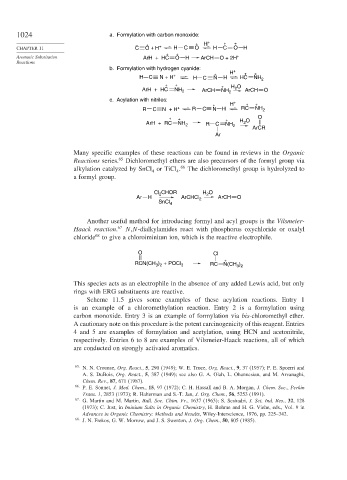Page 1048 - Advanced Organic Chemistry Part B - Reactions & Synthesis
P. 1048
1024 a. Formylation with carbon monoxide:
– + + + H + + +
CHAPTER 11 C O + H H C O H C O H
+ +
Aromatic Substitution ArH + HC O H ArCH O +2H +
Reactions
b. Formylation with hydrogen cyanide:
H + + +
+
H C N + H + H C N H HC NH 2
+ + + H O
ArH + HC NH 2 ArCH NH 2 2 ArCH O
c. Acylation with nitriles: +
+ H + +
R C N + H + R C N H RC NH 2
+ + + O
2
ArH + RC NH 2 R C NH 2 H O ArCR
Ar
Many specific examples of these reactions can be found in reviews in the Organic
Reactions series. 65 Dichloromethyl ethers are also precursors of the formyl group via
alkylation catalyzed by SnCl or TiCl . 66 The dichloromethyl group is hydrolyzed to
4 4
a formyl group.
CHOR H O
Cl 2 2
Ar H ArCHCl 2 ArCH O
SnCl 4
Another useful method for introducing formyl and acyl groups is the Vilsmeier-
Haack reaction. 67 N,N-dialkylamides react with phosphorus oxychloride or oxalyl
chloride 68 to give a chloroiminium ion, which is the reactive electrophile.
O Cl
+
RCN(CH ) + POCl 3 RC N(CH 3 2
)
3 2
This species acts as an electrophile in the absence of any added Lewis acid, but only
rings with ERG substituents are reactive.
Scheme 11.5 gives some examples of these acylation reactions. Entry 1
is an example of a chloromethylation reaction. Entry 2 is a formylation using
carbon monoxide. Entry 3 is an example of formylation via bis-chloromethyl ether.
A cautionary note on this procedure is the potent carcinogenicity of this reagent. Entries
4 and 5 are examples of formylation and acetylation, using HCN and acetonitrile,
respectively. Entries 6 to 8 are examples of Vilsmeier-Haack reactions, all of which
are conducted on strongly activated aromatics.
65
N. N. Crounse, Org. React., 5, 290 (1949); W. E. Truce, Org. React., 9, 37 (1957); P. E. Spoerri and
A. S. DuBois, Org. React., 5, 387 (1949); see also G. A. Olah, L. Ohannesian, and M. Arvanaghi,
Chem. Rev., 87, 671 (1987).
66 P. E. Sonnet, J. Med. Chem., 15, 97 (1972); C. H. Hassall and B. A. Morgan, J. Chem. Soc., Perkin
Trans. 1, 2853 (1973); R. Halterman and S.-T. Jan, J. Org. Chem., 56, 5253 (1991).
67 G. Martin and M. Martin, Bull. Soc. Chim. Fr., 1637 (1963); S. Seshadri, J. Sci. Ind. Res., 32, 128
(1973); C. Just, in Iminium Salts in Organic Chemistry, H. Bohme and H. G. Viehe, eds., Vol. 9 in
Advances in Organic Chemistry: Methods and Results, Wiley-Interscience, 1976, pp. 225–342.
68
J. N. Frekos, G. W. Morrow, and J. S. Swenton, J. Org. Chem., 50, 805 (1985).

